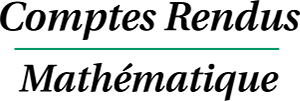[Un modèle de chimiotactisme motivé par l'angiogénèse]
We consider a simple model arising in modeling angiogenesis and more specifically the development of capillary blood vessels due to an exogenous chemo-attractive signal (solid tumors for instance). It is given as coupled system of parabolic equations through a nonlinear transport term. We show that, by opposition to some classical chemotaxis model, this system admits a positive energy. This allows us to develop an existence theory for weak solutions. We also show that, in two dimensions, this system admits a family of self-similar waves.
Nous considérons un modèle simplifié intervenant dans la modélisation de l'angiogénèse et plus précisément le développement de vaisseaux sanguins capillaires sous l'effet d'un signal chemo-attractif exogène (tumeurs solides par exemple). Il s'agit d'un système parabolique couplé par un terme de transport non linéaire. Nous montrons que, contrairement au cas d'autres modèles de chimiotactisme, ce système admet une énergie positive. Ceci nous permet de développer une théorie d'existence de solutions faibles. Nous montrons aussi que, en deux dimensions, ce système admet une famille de solutions autosimilaires.
Accepté le :
Publié le :
L. Corrias 1 ; B. Perthame 2 ; H. Zaag 2
@article{CRMATH_2003__336_2_141_0,
author = {L. Corrias and B. Perthame and H. Zaag},
title = {A chemotaxis model motivated by angiogenesis},
journal = {Comptes Rendus. Math\'ematique},
pages = {141--146},
publisher = {Elsevier},
volume = {336},
number = {2},
year = {2003},
doi = {10.1016/S1631-073X(02)00008-0},
language = {en},
}
L. Corrias; B. Perthame; H. Zaag. A chemotaxis model motivated by angiogenesis. Comptes Rendus. Mathématique, Volume 336 (2003) no. 2, pp. 141-146. doi : 10.1016/S1631-073X(02)00008-0. https://comptes-rendus.academie-sciences.fr/mathematique/articles/10.1016/S1631-073X(02)00008-0/
[1] A mathematical model for capillary network formation in the absence of endothelial cell proliferation, Appl. Math. Lett., Volume 11 (1998) no. 3, pp. 109-114
[2] Modeling and mathematical problems related to tumors immune system interactions, Math. Comput. Modelling, Volume 31 (2000), pp. 413-452
[3] Collapsing bacterial cylinders, Phys. Rev. E, Volume 64 (2001) no. 061904
[4] Diffusion, attraction and collapse, Nonlinearity, Volume 12 (1999) no. 4, pp. 1071-1098
[5] Physical mechanisms for chemotactic pattern formation by bacteria, Biophys. J., Volume 74 (1998), pp. 1677-1693
[6] Avascular growth, angiogenesis and vascular growth in solid tumors: the mathematical modelling of the stages of tumor development, Math. Comput. Modelling, Volume 23 (1996), pp. 47-87
[7] M.A.J. Chaplain, L. Preziosi, Macroscopic modelling of the growth and developement of tumor masses. Preprint no. 27, Politecnico di Torino, 2000
[8] Steady-state solutions of a generic model for the formation of capillary networks, Appl. Math. Lett., Volume 13 (2000) no. 5, pp. 127-132
[9] E. De Angelis, P.-E. Jabin, Analysis of a mean field modelling of tumor and immune system competition, Preprint ENS-DMA 02-19, to appear in Math. Models Methods Appl. Sci
[10] Lyapunov functions and Lp estimates for a class of reaction–diffusion systems, Colloq. Math., Volume 87 (2001) no. 1, pp. 113-127
[11] On explosions of solutions to a system of partial differential equations modelling chemotaxis, Trans. Amer. Math. Soc., Volume 239 (1992) no. 2, pp. 819-824
[12] A. Marrocco, 2D simulation of chemotactic bacteria agreggation, Preprint, 2002
[13] Finite-time aggregation into a single point in a reaction–diffusion system, Nonlinearity, Volume 10 (1997) no. 6, pp. 1739-1754
[14] A system of reaction diffusion equations arising in the theory of reinforced random walks, SIAM J. Appl. Math., Volume 57 (1997), pp. 683-730
[15] Mathematical modelling of the onset of capillary formation initiating angiogenesis, J. Math. Biol., Volume 42 (2001), pp. 195-238
[16] On a system of non-linear strongly coupled partial differential equation arising in biology (Everitt; Sleeman, eds.), Conf. on Ordinary and Partial Differential Equation, Lectures Notes in Math., 846, Springer-Verlag, New York, 1980, pp. 290-298
[17] Finite time blow-up in some models of chemotaxis, J. Math. Biol., Volume 33 (1995), pp. 388-414
[18] A mathematical analysis of a model for capillary network formation in the absence of endothelial cell proliferation, Appl. Math. Lett., Volume 12 (1999) no. 8, pp. 121-127
Cité par Sources :
Commentaires - Politique



Vous devez vous connecter pour continuer.
S'authentifier